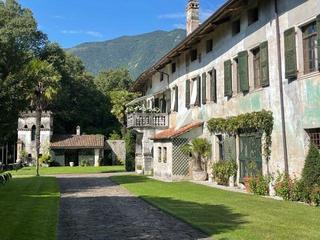
Palazzi e dintorni
If you take a walk in the historic town centre you can appreciate the majesty of palaces that are worth a look for their historical and architectural relevance like Palazzo Scolari-Salice (XVI century), Palazzo Fullini-Zaia (second half XVII century), Palazzo Manin-Cecconi-Zaro (XVI- XVII century), Palazzo Polcenigo (XVI century) and Palazzo Pezzutti (XVII century).
The Scolari-Salice Palace first belonged to the Fabris family then to the Mainardis and in the 19th century to Pietro Quaglia, who handed it down to his daughter married to Professor Francesco Saverio Scolari, a patriot and member of Parliament. The small portico on the outside boasts ancient columns with coats of arms, while the inside shows fine stone finishing and antique furniture. The inner yard admits to a lovely terraced Italian garden, designed by Pietro Quaglia himself which still preserves the old narrow paths leading uphill as well as hedges, plants and rare hundred-year-old trees.
The Fullini-Zaia Palace, probably designed by Domenico Rossi is a stately building overlooking Piazza Plebiscito. The palace boasts two great mullioned windows with three lights, an ashlar work arcade and odd masks. It still preserves delicate XIX century stuccos, ancient pieces of furniture, paintings and a beautiful staircase. In 1809, on the eve of the Camolli battle, won by the Austrians, the palace hosted Napoleon’s stepson and Italy’s viceroy, Eugenie de Beauharnais.
The Manin-Zaro Palace is an example of late Venetian style. It is adorned with marble and stucco ornaments and a great central three-mullioned window that embellishes the façade overlooking Via Coltura.
The movie theatre is a massive building that was probably used as a warehouse by the counts of Polcenigo. In the second half of the 19th century it hosted concerts and theatrical performances by local amateurs. Nowadays, after major renovations, visitors can enjoy the cosy atmosphere of the new movie theatre on the ground floor and learn about the history of the chefs from the Pedemontana area at the Museum of Cooking Arts.
Noteworthy are also St. Lawrence’s (early XIII century) in Coltura and St. John’s (XIV-XVIII century), in San Giovanni.
We can’t forget Mezzomonte, the little hamlet once called Nuvolone, that develops on the mountain slope behind Polcenigo at an altitude of 477 mts. It is a marvellous balcony overlooking the plain below. The village has a fascinating architecture of stone houses clustered at different heights.


